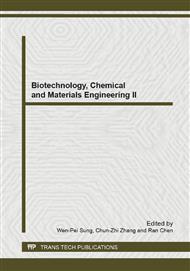p.894
p.898
p.902
p.906
p.910
p.915
p.919
p.923
p.927
Preparation and Properties of Multiple Layer Silk Fibroin Film Incorporating Sulfadiazine Sodium
Abstract:
Silk fibroin film (SFF) has good mechanical property, cells compatibility and biodegradability, and was widely used in the biomedical area as controlling materials. In this work, silk fibroin (SF) was obtained from cocoons. It was dissolved in distilled water to form 5 % and 8 % (W/V) SF solution, which was used to prepare 0.5 %, 1.0 % and 2 % (W/V) sulfadiazine sodium (SD) solution. Five layers of SFF was prepared with salivation method, dried under 37 °C, and annealed with 90 % (V/V) methanol. The structure information was analyzed by FT-IR and SEM, SD release in PBS (0.2 mol/L, pH 7.4) and PBS containing 2 U/ml trypsin at 37 °C was measured. The FT-IR spectra showed that more β-sheet was formed after annealed by methanol; a lot of pores were in the SFF and SD was embedded in SFF through analyzing the image of SEM. The release speed from SFF made by 5 % SF solution was faster than that from SFF made by 8 % SF solution. As for SFF containing different concentration of SD, the release rate improved with the increase of concentration of SD, however, the time of reaching the maximum were approximate. In PBS with trypsin, the time of reaching the maximum accumulative release was one hour earlier compared with in the PBS. Therefore, we draw a conclusion that the SFF incorporating SD has good properties and it has the feasibility to be used as artificial skin for burned patients.
Info:
Periodical:
Pages:
910-914
Citation:
Online since:
January 2013
Authors:
Keywords:
Price:
Сopyright:
© 2013 Trans Tech Publications Ltd. All Rights Reserved
Share:
Citation:


